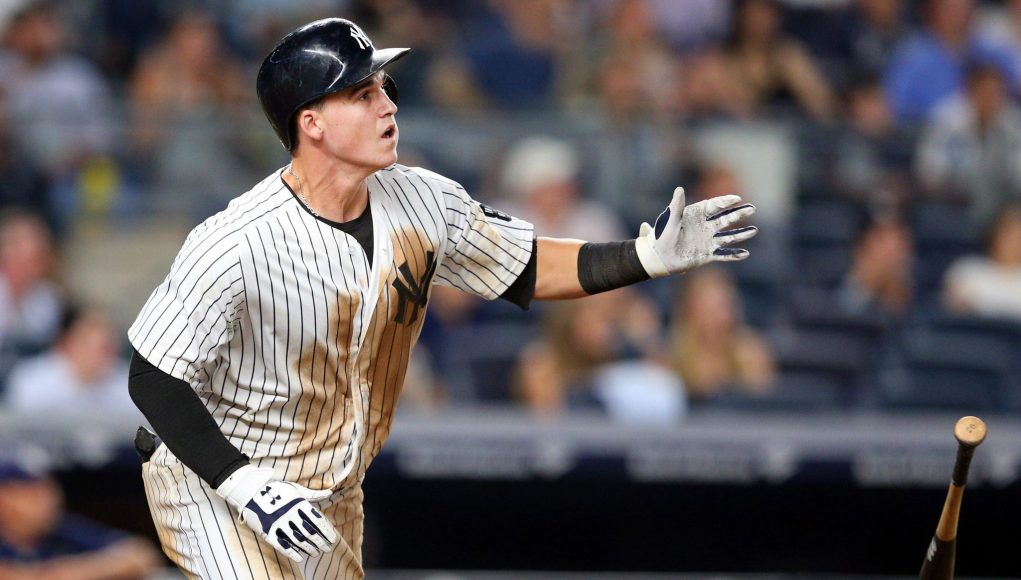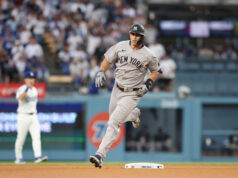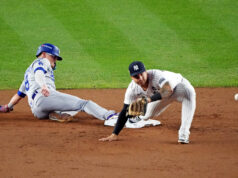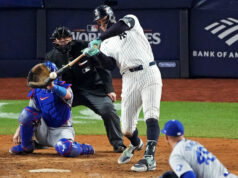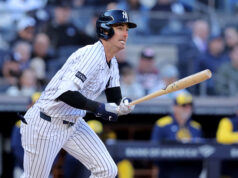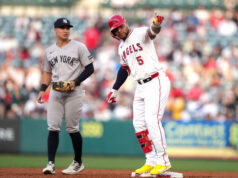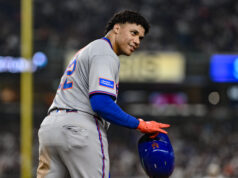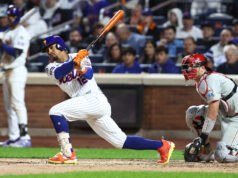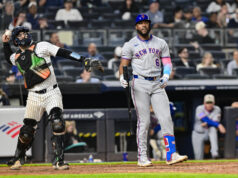With a job opening at the designated hitter’s position for the New York Yankees, they should look no further than their own organization to fill it.
It’s just too “New York Yankees-like” isn’t it?They have money to work with, a position to fill and a stacked market with the capability of bringing along an influential force that can change the complexity of the lineup. How can they not cave and spend some of their dough?
Following the trade of Brian McCann, Brian Cashman has roughly $136 million on the books — before arbitration. With that, he could very well bring in a top tier closer like Aroldis Chapman and one of the big bats via free agency with room to get under the luxury tax threshold.
Some of those “big bats” include that of Edwin Encarnacion, who would undoubtedly transform the Bombers’ offense from the one that finished second-to-last in batting average with runners in scoring position to a potent one.
Encarnacion, who finished in the top-15 in the American League MVP voting in three of the past four seasons, has hit 193 home runs and has maintained a .272/.367/.544 slash line with an OPS of .912 since 2012.
In 2016, he finished tied with David Ortiz for the most RBI (127). More impressively, though, no hitter in baseball has more home runs than Encarnacion does (210) since 2011.
On one hand, he’ll vastly improve the lineup. On the other hand, does handing out a big contract to what will be a full-time designated hitter make sense?
Spotrac estimates Encarnacion’s market value to be able to wheel in a five-year, $117-million deal which will bring in yet another long-term commitment someone that will be 34 on Opening Day.
At 39 years of age by the end of a deal in that class, who could say for certain that Encarnacion would continue his production he has had since 2011? If Cashman and co. learned anything from Alex Rodriguez’s mess, the odds haven’t been in their favor in that regard.
So, does he just not address it and leave a spot vacant while filling it with a lesser option? Their current option may be inferior momentarily, but the Yankees already have a DH who can provide more than just some pop.
25-year old Tyler Austin, despite striking out in 43% of his 83 at-bats, went 6-for-12 with two home runs in his last five games of his first cup of coffee and owned a .348/.444/.652 slash line with a 1.097 OPS against lefties.
Overall, he hit five home runs in 31 games, a total of 26 long balls when proportioned to 162 games.
What made Austin unique, however, was his clutch gene along with the fact that all of his home runs were smashed to the opposite field — at an average of 375.8 feet, according to ESPN home run tracker.
As mentioned, though, he did strikeout in 43% of his at-bats and while he has a track record of perseverance, he is an unproven kid who is, by no means, a given to provide the pop from the right side that will drive New York’s offense into a sturdy one — like Encarnacion can.
So what does Austin bring the Yankees that the 12-year veteran can’t? Flexibility.
If they decide to stay in-house and utilize Austin as their primary DH, the Yankees have the ability to keep Gary Sanchez fresh with frequent appearances in the lineup not as the starting catcher.
17 of Sanchez’s 53 historic games in his rookie campaign were played as the designated hitter, which does a lot in terms of consistency and strength for a backstop throughout the course of an entire major league baseball season.
Speaking of strength, a fully recovered Greg Bird, who slugged 11 home runs in 46 games in 2015, very well may be the greatest source of power in New York’s lineup. Keeping him sharp with frequent days as the DH could bode well for his shoulder after coming off a year-long labrum injury.
Austin could do the same for Aaron Judge and is fully capable of handling both the first base and right field position. Conceivably, a promising youngster who could see some time in the field and fill the DH role by mixing and matching could further give the organization a nice look at their young talent.
After all, 2017 should be treated no more or less than the second half of 2016 which was all about seeing what the Baby Bombers have in store. Handing the role to Austin will give the organization a golden opportunity to do just that.
It would be ignorant to not look at the other side, however. Encarnacion or any other DH option (I subjectively regard Carlos Beltran as the most sensical option on the market thanks to the short commitment) won’t derail the youth movement hype train that’s making its way over to 161st St.
Ortiz didn’t exactly halt the wave of youth that shipped its way up to Boston during his last years as a Red Sock.
Having a veteran power bat can and logically will profit the offense that finished second-to-last in batting average with runners in scoring position. Furthermore, their presence should relieve some of the burden off the youngsters through the unavoidable ups and downs that most kids encounter in the initial stages of their career.
You see it everywhere. The Sox with Ortiz, the World Champion Cubs with David Ross, the Indians with Mike Napoli and much much more.
Enhancing the athletic talent blooming in the Yankees’ system with a big bat would bring what every successful baseball clubs contains: balance.
That approach would make sense, if it wasn’t going to throw the rebuilding Bombers right back into the glutinous contract situations they’re aiming to rid themselves of.
After shaving $58 million in salaries this year, New York will cast away an additional $45 million off their payroll after the 2017 season with the terminating contracts of CC Sabathia and Alex Rodriguez.
Wouldn’t the Yankees be better off if they recommended the course inaugurated back at the trade deadline and proceeded to unload space for the stacked free agent class of 2018 rather than invest five years in a 34-year old?
Don’t think of staying in-house as demanding kids to clinch the Yankees’ 28th World Series title. With less that one year of experience for most of them, that’s asinine. Think of this approach as what year two of a rebuild should resemble: the dawn of a new era.
See if these wildly touted prospects are for real and could possibly be the core of a new franchise. Shun the practice of handing out large deals to washed up players on the wrong side of 30 for the hope they can maintain their contemporary level of production.
A big signing or even a trade for a proven superstar could sell some jerseys and some seats, but the Yankees are more than one right-handed hitter away from being championship-caliber. A lot still needs to go their way, and more.
This is still a rebuilding team and there’s absolutely no need to gamble it all away and potentially damage the partially completed infrastructure that is the new wave of superstars. Patience is a virtue.


